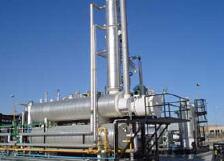All in-well produced natural gas streams contain water vapor as they leave the reservoir. Free or liquid water may also be produced along with the natural gas. As the gas travels up the wellhead to the surface, it cools due to depressurization and heat transfer with the cooler formation. As the gas temperature decreases, the ability of the gas to hold water vapor decreases, thus the gas is almost always saturated with water vapor when it reaches the surface. Excessive cooling of saturated gas can cause water cooling. If the gas is further cooled, hydrates (solid, crystalline aqueous hydrocarbon compounds) can form.
Gas treatment or sweetening refers to various processes that remove a specific impurity from natural gas or hydrocarbon liquids, the main impurities being hydrogen sulfide (H2S) and carbon dioxide (CO2). CO2 and H2S are also referred to as "sour gas" because they form an acid solution when dissolved in water. These impurities are also removed because of their toxicity, corrosiveness, freezing problems and the control of the overall heating temperature of the gas. In addition to CO2 and H2S, specific amines are also needed to remove sulfuric acid, carbon oxysulfide (CS2), carbon disulfide (COS) and mercaptans (RSH) if they are present in sufficient quantities.
